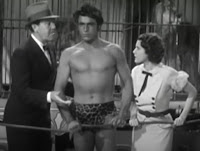The Knolls family gets a permit to go into lion country in Kenya on a photographic safari. When lions attack their camp, the parents are killed but their 5-year-old son survives and is raised by a lion family as if he were a cub. Years later, he's all grown-up, wearing a loincloth and living with the lions (whom he communicates with by roaring) and sometimes protecting them. We pick the story up again as a rancher (Douglas Dumbrille) is trying to ward off attacks by lions on his cattle—the lions are starving due to drought and desperate for food. Crabbe sneaks onto his property and lets the cattle loose for the lions to feast on. Hunter Robert Barrat, who is looking to trap some lions to sell to circus manager Sidney Toler, tells Dumbrille that it was probably the work of the rumored Lion Man. They set up their own trap for the lions and manage to bag a handful, and the Lion Man as well. Sent to the States, Crabbe jumps off the ship as it comes into the harbor, gets to land, jumps through the first suburban dining room window he sees, and starts eating off the freshly set plates. He is discovered by Frances Dee who wants to help him, but her friend calls the police and Crabbe is taken back to Toler. Dee winds up accompanying him and becomes a friend, teacher, and confidante (and perhaps a romantic interest, though that is mostly downplayed). At the circus, Toler ends up putting Crabbe on salary and featuring him in a lion taming act and he's a hit—as he also is with some of the female members of the circus troupe. He tells Dee that his plan is to make enough money to buy the lions and take them back to Kenya. Things go sideways when a hired hand (Warner Richmond) taunts one of the lions and gets his hand bitten off; for revenge, he tries to poison the lion. Toler catches him, but not before he has set a fire that rages through the circus, setting off lions, a tiger, and some elephants. Can Crabbe save the day?
Clearly, this was a mid-budget attempt by Paramount to steal some of MGM's A-budget Tarzan thunder a year after the first Ape Man movie was released. Supposedly Crabbe, a swimming champ, tried out the role of Tarzan but lost it to Johnny Weissmuller, also a swimming champ. But though there are similarities in the backstory, this quickly sets itself up in a different direction, with the bulk of the movie set in the States as Crabbe becomes civilized and educated. Whereas Tarzan (in the first couple of movies at least) remains in a relatively uncivilized state of nature, Crabbe can pass for fully socialized in manner and dress—though he continues to wear that abbreviated loincloth in his circus act, which not only shows off Crabbe's nice physique, but also his comely ass (it's basically a thong). His somewhat light vocal delivery lacks danger, making him a less threatening figure than Tarzan. Frances Dee is nicely befuddled at first but grows to truly care for Crabbe (his character is given the name Kaspa by Toler, which has no significance). I like there are few real villains here: Toler, who is in fact engaging in human trafficking, treats Crabbe well; Barrat is just doing his job (frowned upon nowadays though it may be), and Dumbrille is justified in trying to save his cattle—once we leave Africa, we hear no more about those two. Only Richmond is a hissable bad guy, and he's not around long enough to think about much. The fiery climax is well done. This was a pleasant surprise, and if there had been a sequel, I'd watch it with pleasure. Crabbe (best known as Flash Gordon and Buck Rogers in the 30s serials) would eventually play Tarzan later that year in the serial TARZAN THE FEARLESS, which is now considered lost but can be seen in an 85-minute feature film version. Pictured are Toler, Crabbe and Dee. [YouTube]

















